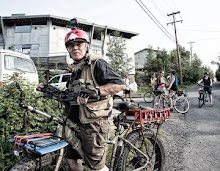Creating audio
Submitted by adam on Wed, 08/26/2009 - 22:50.http://www.messageinabox.tacticaltech.org/creatingaudio
Putting together recordings of sounds to make audio content is no longer the preserve of experts. The use of audio for campaigning and advocacy is a growing phenomenon. In this chapter you will find out how anyone with a plan, an idea, some basic equipment and a little background knowledge can create and distribute engaging and good quality audio. This section will enable you to create audio content that is powerful and relevant, and to distribute it to audiences using radio, CDs, public spaces and the internet. It also provides a number of case studies that show the many ways audio can be used in human rights advocacy work.
 |
| A Zapatista radio station in Mexico. Photo by Oriana Eliçabe. |
How can you use audio recordings?
You can make audio recordings and play them in public places, use them to enhance your website and broadcast them on the radio; you can distribute them as CDs, as mobile phone ringtones or as podcasts that listeners can download from the internet. Audio recordings can be educational or campaigning; they communicate in many ways.
Audio work which is broadcast via radio or podcast can be both intimate and far-reaching; both private – because people often listen by themselves while getting on with their lives – and public, because many people may be listening to them at the same time. This sort of transmission can be heard by large numbers of people who may not otherwise be exposed to your message, and provide them with compelling information while connecting them with diverse experiences and voices.
Audiences
Producing informative and entertaining audio is an effective way of reaching the large and varied audiences who listen to CDs, radio stations and online broadcasts. Rural audiences tend to use radio more than any other medium, particularly if it is in their local language; people who are not literate also find audio a powerful way to access information and learn. Increasingly, people who have internet access are 'switched on' to online audio, particularly young audiences.
What resources do you need?
The cost of making audio is relatively low. You will need to have access to an audio recording device – preferably a digital one – and then access to software for editing the sounds you record into a distributable audio piece. It is also possible to record sound using old-style analogue tape recorders (such as a 'Walkman', which records onto cassette tapes), and then feed this analogue sound into a computer, which converts it into digital sounds for editing (Read more about Audacity).
Audacity is an easy-to-use audio edit or and recorder for Windows, Mac OS X, GNU/Linux and other operating systems. You can use Audacity to:
- Record live audio
- Convert analogue tapes and records into digital recordings or CDs
- Edit sound files in different formats together
- Cut, copy, splice or mix sounds together
- Change the speed or pitch of a recording
What skills do you need?
For making your initial audio recordings all that is required is to capture the sound as well as possible, by listening carefully to your interviewee or subject and adjusting the sound input levels as necessary. The editing stage requires more skill, but is also increasingly accessible to the beginner.
How long will it take to make your audio piece?
Audio pieces normally range in length from 30 seconds (the length of most radio or TV ads) to five minutes (the length of most news items on a radio programme). Documentaries and longer features, however, may be up to half an hour in length or more. Radio producers tend to consider that one hour of work is required for every five minutes broadcast. This rule is not a scientific assessment but one based on experience; of course this will vary enormously with the nature of the audio piece and the experience and resources of the maker/s. At least half of this time is spent sourcing and recording the piece; the rest is taken up with editing, and with distributing it to listeners.


